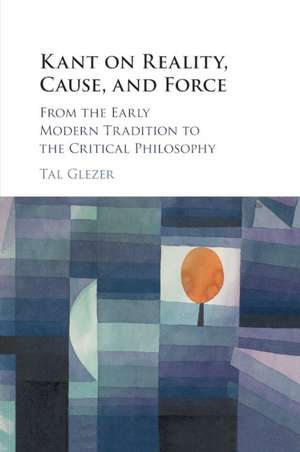Kant on Reality, Cause, and Force: From the Early Modern Tradition to the Critical Philosophy
Autor Tal Glezeren Limba Engleză Paperback – 8 ian 2020
Preț: 282.48 lei
Nou
Puncte Express: 424
Preț estimativ în valută:
54.06€ • 56.10$ • 45.18£
54.06€ • 56.10$ • 45.18£
Carte tipărită la comandă
Livrare economică 17-31 martie
Preluare comenzi: 021 569.72.76
Specificații
ISBN-13: 9781108430777
ISBN-10: 1108430775
Pagini: 241
Dimensiuni: 150 x 229 x 13 mm
Greutate: 0.33 kg
Editura: Cambridge University Press
Colecția Cambridge University Press
Locul publicării:Cambridge, United Kingdom
ISBN-10: 1108430775
Pagini: 241
Dimensiuni: 150 x 229 x 13 mm
Greutate: 0.33 kg
Editura: Cambridge University Press
Colecția Cambridge University Press
Locul publicării:Cambridge, United Kingdom
Cuprins
Acknowledgements; List of abbreviations; Introduction: 'what corresponds to sensation'; Part I. Substantial Forms and Reality: 1. Reality and substantial forms in Descartes and Suárez; 1.1. Reality-containment and substantial forms in Descartes and Suárez; 1.2. Causation and substantial forms in Descartes and Suárez; 1.3. Descartes on the intelligibility of substantial forms; 2. Vis Viva and the essence of matter; 2.1. Vis Viva and quantity of motion; 2.2. Vis Viva and 'quantity of progress'; 2.3. Vis Viva and potential energy; 2.4. Potential energy and substantial forms; 2.5. Living and dead forces, primitive and derivative forces in Leibniz's Specimen Dynamicum; 2.6. The principle of sufficient reason and the intelligibility of substantial forms; 3. Leibniz on the law of continuity; 3.1. Leibniz on the law of continuity in mathematics; 3.2. Leibniz on the law of continuity in physics; 3.3. Leibniz's law of continuity and genus-species subordination; Part II. The Magnitude of Reality: 4. Reality and magnitude in Kant's Negative Magnitudes; 4.1. The validity of mathematical concepts in philosophy; 4.2. Negative magnitudes and real opposition; 4.3. Kant's main argument in Negative Magnitudes Section III; 4.4. Ground and consequence, and the law of continuity in Negative Magnitudes; 5. The category of reality and the law of continuity; 5.1. Kant's classification of laws of continuity; 5.2. Laws of continuity in Kant's Inaugural Dissertation; 5.3. The law of continuity's place in the table of categories; 5.4. The ground of sensation in the Inaugural Dissertation and in the CPR; 6. Objectivity and the quantification of reality; 6.1. Objectivity and the concepts of quality; 6.2. Why qualities should have quantities; 6.3. Intensive magnitudes and the anticipations of perception; 7. Reality, causation, and motion; 7.1. Reality and causation; 7.2. Simultaneous and instantaneous causation; 7.3. Reality and motion; 7.4. Reality, motion, and the moment of change; Part III. The All of Reality: 8. Metaphysical and mechanical laws of the continuity of alteration; 8.1. The continuity of alteration in the CPR; 8.2. The continuity of alteration in the MFNS; 9. The second analogy and the uniformity of nature; 9.1. The second analogy and the existence of empirical laws; 9.2. 'An unbounded diversity of empirical laws'; 9.3. The applicability of transcendental principles in experience; 10. Reality and the system of all possible empirical concepts; 10.1. Kant and Leibniz on the idea of a system of all possible empirical concepts; 10.2. Transcendental ideas and the concept of realitas noumenon; 10.3. Transcendental ideas and the pure use of reason; 10.4. Transcendental ideas and the property of continuity; 10.5. The transcendental ideas and the regulative principles of science; 11. Reality and the derivation of rgavitation; 11.1. Kant's example of genus-species subordination in the appendix to the dialectic; 11.2. Kant's example and the continuity of conic sections; 11.3. Kant's example and Newton's derivation of gravitation; 11.4. Kant on Newton and the objective validity of motion; 11.5. Kant on genus-species subordination and Newton's derivation of gravitation; Conclusion; Bibliography.
Recenzii
'Kant on Reality, Cause, and Force is the first study to give a coherent account of the complex relationship between qualities, causes, and forces in Kant's philosophy by drawing on important strands in early modern philosophy and science. It is a compelling reconstruction of Kant's critical concept of reality, and, with its distinctively non-psychological viewpoint, it makes an original contribution both to Kant scholarship and to the development of early modern metaphysics and philosophy of nature more broadly.' Konstantin Pollok, University of South Carolina
Notă biografică
Descriere
Original analysis of Kant's category of reality, with wide-ranging implications for understanding his critical philosophy and its development.
